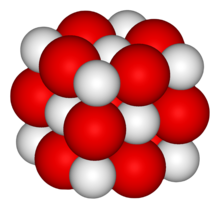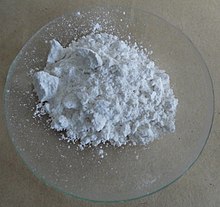Loading AI tools
Chemical compound of calcium From Wikipedia, the free encyclopedia
Calcium oxide (formula: CaO), commonly known as quicklime or burnt lime, is a widely used chemical compound. It is a white, caustic, alkaline, crystalline solid at room temperature. The broadly used term lime connotes calcium-containing inorganic compounds, in which carbonates, oxides, and hydroxides of calcium, silicon, magnesium, aluminium, and iron predominate. By contrast, quicklime specifically applies to the single compound calcium oxide. Calcium oxide that survives processing without reacting in building products, such as cement, is called free lime.[5]
 | |
 Powder sample of white calcium oxide | |
| Names | |
|---|---|
| IUPAC name
Calcium oxide | |
Other names
| |
| Identifiers | |
3D model (JSmol) |
|
| ChEBI | |
| ChEMBL | |
| ChemSpider | |
| ECHA InfoCard | 100.013.763 |
| EC Number |
|
| E number | E529 (acidity regulators, ...) |
| 485425 | |
| KEGG | |
PubChem CID |
|
| RTECS number |
|
| UNII | |
| UN number | 1910 |
CompTox Dashboard (EPA) |
|
| |
| |
| Properties | |
| CaO | |
| Molar mass | 56.0774 g/mol |
| Appearance | White to pale yellow/brown powder |
| Odor | Odorless |
| Density | 3.34 g/cm3[1] |
| Melting point | 2,613 °C (4,735 °F; 2,886 K)[1] |
| Boiling point | 2,850 °C (5,160 °F; 3,120 K) (100 hPa)[2] |
| Reacts to form calcium hydroxide | |
| Solubility in Methanol | Insoluble (also in diethyl ether, octanol) |
| Acidity (pKa) | 12.8 |
| −15.0×10−6 cm3/mol | |
| Structure | |
| Cubic, cF8 | |
| Thermochemistry | |
Std molar entropy (S⦵298) |
40 J·mol−1·K−1[3] |
Std enthalpy of formation (ΔfH⦵298) |
−635 kJ·mol−1[3] |
| Pharmacology | |
| QP53AX18 (WHO) | |
| Hazards | |
| GHS labelling: | |
  | |
| Danger | |
| H302, H314, H315, H335 | |
| P260, P261, P264, P270, P271, P280, P301+P312, P301+P330+P331, P302+P352, P303+P361+P353, P304+P340, P305+P351+P338, P310, P312, P321, P330, P332+P313, P362, P363, P403+P233, P405, P501 | |
| NFPA 704 (fire diamond) | |
| Flash point | Non-flammable[4] |
| NIOSH (US health exposure limits): | |
PEL (Permissible) |
TWA 5 mg/m3[4] |
REL (Recommended) |
TWA 2 mg/m3[4] |
IDLH (Immediate danger) |
25 mg/m3[4] |
| Safety data sheet (SDS) | ICSC 0409 |
| Related compounds | |
Other anions |
Calcium sulfide Calcium hydroxide Calcium selenide Calcium telluride |
Other cations |
Beryllium oxide Magnesium oxide Strontium oxide Barium oxide Radium oxide |
Except where otherwise noted, data are given for materials in their standard state (at 25 °C [77 °F], 100 kPa).
| |
Quicklime is relatively inexpensive. Both it and the chemical derivative calcium hydroxide (of which quicklime is the base anhydride) are important commodity chemicals.
Calcium oxide is usually made by the thermal decomposition of materials, such as limestone or seashells, that contain calcium carbonate (CaCO3; mineral calcite) in a lime kiln. This is accomplished by heating the material to above 825 °C (1,517 °F),[6][7] a process called calcination or lime-burning, to liberate a molecule of carbon dioxide (CO2), leaving quicklime behind. This is also one of the few chemical reactions known in prehistoric times.[8]
The quicklime is not stable and, when cooled, will spontaneously react with CO2 from the air until, after enough time, it will be completely converted back to calcium carbonate unless slaked with water to set as lime plaster or lime mortar.
Annual worldwide production of quicklime is around 283 million tonnes. China is by far the world's largest producer, with a total of around 170 million tonnes per year. The United States is the next largest, with around 20 million tonnes per year.[9]
Approximately 1.8 t of limestone is required per 1.0 t of quicklime. Quicklime has a high affinity for water and is a more efficient desiccant than silica gel. The reaction of quicklime with water is associated with an increase in volume by a factor of at least 2.5.[10]
Hydroxyapatite's free CaO content rises with increased calcination temperatures and longer times. It also pinpoints particular temperature cutoffs and durations that impact the production of CaO, offering information on how calcination parameters impact the composition of the material.
In 80 BC, the Roman general Sertorius deployed choking clouds of caustic lime powder to defeat the Characitani of Hispania, who had taken refuge in inaccessible caves.[23] A similar dust was used in China to quell an armed peasant revolt in 178 AD, when lime chariots equipped with bellows blew limestone powder into the crowds.[24]
Quicklime is also thought to have been a component of Greek fire. Upon contact with water, quicklime would increase its temperature above 150 °C (302 °F) and ignite the fuel.[25]
David Hume, in his History of England, recounts that early in the reign of Henry III, the English Navy destroyed an invading French fleet by blinding the enemy fleet with quicklime.[26] Quicklime may have been used in medieval naval warfare – up to the use of "lime-mortars" to throw it at the enemy ships.[27]
Limestone is a substitute for lime in many applications, which include agriculture, fluxing, and sulfur removal. Limestone, which contains less reactive material, is slower to react and may have other disadvantages compared with lime, depending on the application; however, limestone is considerably less expensive than lime. Calcined gypsum is an alternative material in industrial plasters and mortars. Cement, cement kiln dust, fly ash, and lime kiln dust are potential substitutes for some construction uses of lime. Magnesium hydroxide is a substitute for lime in pH control, and magnesium oxide is a substitute for dolomitic lime as a flux in steelmaking.[28]
Because of vigorous reaction of quicklime with water, quicklime causes severe irritation when inhaled or placed in contact with moist skin or eyes. Inhalation may cause coughing, sneezing, and labored breathing. It may then evolve into burns with perforation of the nasal septum, abdominal pain, nausea and vomiting. Although quicklime is not considered a fire hazard, its reaction with water can release enough heat to ignite combustible materials.[29][better source needed]
Calcium oxide is also a separate mineral species (with the unit formula CaO), named 'Lime'.[30][31] It has an isometric crystal system, and can form a solid solution series with monteponite. The crystal is brittle, pyrometamorphic, and is unstable in moist air, quickly turning into portlandite (Ca(OH)2).[32]
Seamless Wikipedia browsing. On steroids.
Every time you click a link to Wikipedia, Wiktionary or Wikiquote in your browser's search results, it will show the modern Wikiwand interface.
Wikiwand extension is a five stars, simple, with minimum permission required to keep your browsing private, safe and transparent.